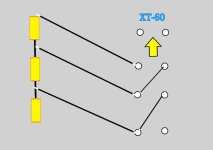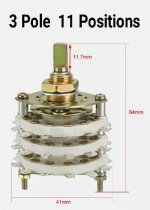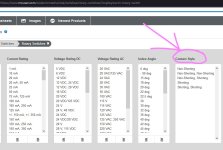SafeDiscDancing
10 kW
- Joined
- Jan 3, 2022
- Messages
- 514
MBM Manual Battery Management
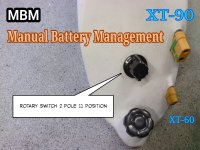
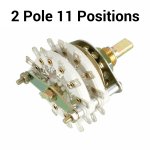
I have used cheap Chinese balancing boards and found they failed easily and never achieved anything I thought was of value. At some point I realized "Why not simply manually manage a battery?"
Another big revelation was that "Bottom Balancing" is really the way to go for protecting your individual cells because it's when you are out riding and run too low that damage happens. "Bottom Balancing" means you get a very clear warning you are out of charge.
Anyway... the concept is very simple.
The XT-90 is your "Power" connection.
The XT-60 gives direct access to "Individual Cells". (so you read 2.5 volts to 4.2 volts there)
The Rotary Switch simply "Changes the Channel" so you access the cells one at a time.
And the great thing about it is you can use a big Resistor to lower the charge or I have a hacked USB that can add 5 volts at 2 amps. Everything can be balanced pretty fast.
Once you get everything right it does not deviate much.
This pack has 10S so with 11 Positions I have a spare "OFF" option. Things would get more difficult with more cells because most of these are limited to 11 Positions.
I probably ought to do the electrical diagram... but maybe on a later post. It's pretty easy to figure out.


I have used cheap Chinese balancing boards and found they failed easily and never achieved anything I thought was of value. At some point I realized "Why not simply manually manage a battery?"
Another big revelation was that "Bottom Balancing" is really the way to go for protecting your individual cells because it's when you are out riding and run too low that damage happens. "Bottom Balancing" means you get a very clear warning you are out of charge.
Anyway... the concept is very simple.
The XT-90 is your "Power" connection.
The XT-60 gives direct access to "Individual Cells". (so you read 2.5 volts to 4.2 volts there)
The Rotary Switch simply "Changes the Channel" so you access the cells one at a time.
And the great thing about it is you can use a big Resistor to lower the charge or I have a hacked USB that can add 5 volts at 2 amps. Everything can be balanced pretty fast.
Once you get everything right it does not deviate much.
This pack has 10S so with 11 Positions I have a spare "OFF" option. Things would get more difficult with more cells because most of these are limited to 11 Positions.
I probably ought to do the electrical diagram... but maybe on a later post. It's pretty easy to figure out.


